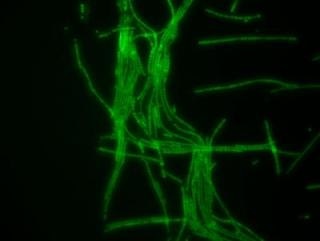Nov 8 2018
A research team from Stevens Institute of Technology has taken a normal white button mushroom available in a grocery store and converted it into a functional bionic system, supercharging it with swirls of graphene nanoribbons and 3D-printed clusters of packed cyanobacteria to make electricity.
 Densely packed cyanobacteria (green) achieved via 3D printing increases electricity-generating behavior. (Image credit: Sudeep Joshi, Stevens Institute of Technology)
Densely packed cyanobacteria (green) achieved via 3D printing increases electricity-generating behavior. (Image credit: Sudeep Joshi, Stevens Institute of Technology)
The cyanobacteria produce electricity, while the swirls of graphene nanoribbons collect that current. Reported in Nano Letters, the study may sound as if it has been taken directly from the popular novel “Alice in Wonderland”; however, the bio-hybrids are part of a wider effort to gain a better understanding of the machinery of cell biology and how to apply those complex molecular levers and gears to develop useful systems and novel technologies for healthcare, defense, and the environment.
In this case, our system - this bionic mushroom - produces electricity. By integrating cyanobacteria that can produce electricity, with nanoscale materials capable of collecting the current, we were able to better access the unique properties of both, augment them, and create an entirely new functional bionic system.
Manu Mannoor, Assistant Professor of Mechanical Engineering, Stevens Institute of Technology.
In the bioengineering field, the ability of cyanobacteria to generate electricity is well known, but scientists faced limitations when it came to applying these microorganisms in bioengineered systems. This is because cyanobacteria cannot survive for a long time on synthetic bio-compatible surfaces. Mannoor along with Sudeep Joshi, a postdoctoral fellow in his laboratory, speculated that since the commonly available white button mushrooms naturally contains a rich microbiota and not cyanobacteria, they could offer the ideal environment—temperature, nutrients, pH, and moisture—and allow the cyanobacteria to generate electricity for an extended period of time.
The duo demonstrated that when cyanobacterial cells were placed on the cap of a white button mushroom vs. a silicone and dead mushroom as appropriate controls, the cells survived several of days longer.
The mushrooms essentially serve as a suitable environmental substrate with advanced functionality of nourishing the energy producing cyanobacteria. We showed for the first time that a hybrid system can incorporate an artificial collaboration, or engineered symbiosis, between two different microbiological kingdoms.
Sudeep Joshi, Postdoctoral Fellow, Stevens Institute of Technology.
Using a robotic arm-based 3D printer, Joshi and Mannoor first printed an "electronic ink" that contained the graphene nanoribbons. Mannoor explained that this uniquely printed branched network acts as an electricity-collecting network atop the cap of the white button mushroom by behaving similar to a nano-probe to access bio-electrons produced within the cyanobacterial cells. It is akin to needles sticking into one cell to access the electrical signals contained in it.
The team then printed a" bio-ink" that contains cyanobacteria onto the cap of the mushroom in a spiral pattern that intersects with the electronic ink at various contact points. Electrons at these locations may transfer through the cyanobacteria’s outer membranes to the graphene nanoribbons’ conductive network. When a light was shone on the mushrooms, it triggered cyanobacterial photosynthesis producing a photocurrent.
Besides the cyanobacteria surviving longer in a state of engineered symbiosis, Joshi and Mannoor demonstrated that the amount of electricity generated by these microbes can differ based on the alignment and density with which they are densely packed—the more closely they are packed together, the more electricity they will generate. Through 3D printing, cyanobacteria can be assembled to increase their electricity-generating activity by as much eight-times more than the casted cyanobacteria utilizing a lab pipette.
In the recent past, several investigators have already 3D printed bacterial cells in various spatial geometrical patterns; however, Mannoor, Joshi, and also co-author Ellexis Cook are not only the first team to pattern it to boost the electricity-generating behavior of the bacterial cells, but are also the first to integrate it to create a functional bionic architecture.
With this work, we can imagine enormous opportunities for next-generation bio-hybrid applications. For example, some bacteria can glow, while others sense toxins or produce fuel. By seamlessly integrating these microbes with nanomaterials, we could potentially realize many other amazing designer bio-hybrids for the environment, defense, healthcare, and many other fields.
Manu Mannoor, Assistant Professor of Mechanical Engineering, Stevens Institute of Technology.